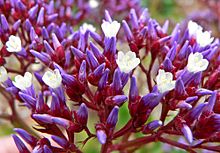Limonium
| Sea-lavender | |
|---|---|
 |
|
| Limonium perezii at the San Francisco Botanical Garden | |
| Scientific classification | |
| Kingdom: | Plantae |
| (unranked): | Angiosperms |
| (unranked): | Eudicots |
| (unranked): | Core eudicots |
| Order: | Caryophyllales |
| Family: | Plumbaginaceae |
| Genus: |
Limonium Mill. |
| Species | |
|
About 120–150 species; see text |
|
About 120–150 species; see text
Limonium is a genus of 120 flower species. Members are also known as sea-lavender, statice, caspia or marsh-rosemary. Despite their common names, species are not related to the lavenders or to rosemary. They are instead in Plumbaginaceae, the plumbago or leadwort family. The generic name is from the Latin līmōnion, used by Pliny for a wild plant and is ultimately derived from the Ancient Greek leimon (, ‘meadow’).
The genus has a subcosmopolitan distribution in Europe, Asia, Africa, Australia and North America. By far the greatest diversity (over 100 species) is in the area stretching from the Canary Islands east through the Mediterranean region to central Asia; for comparison, North America only has three native Limonium species.
Sea-lavenders normally grow as herbaceous perennial plants, growing 10–70 cm tall from a rhizome; a few (mainly from the Canary Islands) are woody shrubs up to 2 metres tall. Many species flourish in saline soils, and are therefore common near coasts and in salt marshes, and also on saline, gypsum and alkaline soils in continental interiors.
...
Wikipedia
